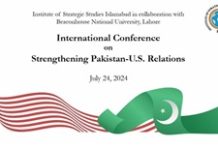What it’s all about
The China-Pakistan Economic Corridor (CPEC) is a “corridor of success”. After about two years of conflicting and opposing views on the CPEC, especially on the route alignment choices, the All-Particles Conference (APC) gave unflinching support and evolved a consensus on the multi-billion project in a meeting held on May28.
The CPEC is now a real national project. Controversy has been fizzled out. Those who have been trying to convert the CPEC into another Kalabagh Dam have been wiped out. The government has hammered out a consensus and brought the entire leadership on the same page to benefit the whole country with Balochistan and Khyber Pukhtunkhwa first. The western route will be built first, giving a Pushtun colour from Hazara to Quetta.
Earlier, leaders criticised the CPEC route alignment being “a Punjabi-dominated” project. This provincial bias has been removed. A Parliamentary Special Committee will supervise and ensure transparency. All provinces and businessmen across the country hailed the project. China has fully endorsed the consensus achieved on the CPEC. The date of 28 May 2015 will be known as a mile stone in country’s history. Earlier, on 28 May 1998 Pakistan became a nuclear country. Now the country will become an economic power and an Asian tiger.
Three routes will be built, western, central, and eastern routes connecting whole of the country with Kashghar in Xinjiang in western China, a city very close to the hearts of Pakistanis historically. This distance will be at least over 3000 km. It is not simply a road but a network of communications and physical connectivity.
In fact, it was Pakistan that gave the idea of the CPEC way back in the 1960s. The idea of the CPEC is as old as the idea of Gwadar Port itself. The idea was actually conceived in 1964 but due to a number of constraints, it was not implemented. The main purpose was to have a deep sea port to anchor large ships in Pakistan as the Karachi Port does not have that capacity, besides it was congested.
The strategic idea was a later thought but the idea was long there to provide facilities to Afghanistan, Central Asia, China, Mongolia, and even Russia as its coasts are closed in winter. The Gwadar Port will run around the year.
Gwadar was being affiliated with China after 2001 as it provided funds of $248 million to construct it and to give a modern shape to this fishermen’s town. China chipped in after 700 km coastal highway was built, lining to Karachi. Probably this gave an idea to China to link up the Gwadar Port with Kashghar.
China completed it in 2007 but did not manage it. On commercial basis, the port was handed over to the Singapore Port Authority (SPA) who could not run it for one or the other reason and violated the contract, which was then cancelled and the management transferred the leasing rights to the China Overseas Port Holding Authority (COPHA) in February 2013 for 40 years up to February 2055.
The SPA might have played the great game for America and India, bringing geo-politics to Gwadar than genuinely running the port on commercial lines. Singapore has special ties with both America and India. China is aware of this fact and would not think of using the Gwadar for naval purposes to abide by contract’s terms and conditions.
Therefore, from no point of view the CPEC has been introducing geo-politics. Some analysts believe that Pakistan is a Chinese pivot in Asia, introducing its commercial and strategic expansion in South Asia and the Arabian Sea. They might see a geo-political perspective of the CPEC as vital economic links will develop between Pakistan and China. Yet the project is not itself a geo-politics project. It is a purely an economic and commercial project, injecting a new dimension to the Sino-Pakistani relations in the 21 Century.
After achieving national consensus on the CPEC, Pakistan should ignore India’s objections. If India is concerned about the CPEC going through disputed Kashmiri territory under control by Pakistan, and objecting the building of Diamir-Bhasha dam, inter alia, it should quickly come up to help with the plebiscite in Kashmir to ascertain the people’s choice. Development and progress can no longer be deferred. Poverty is not the eternal fate of the people of Kashmir and Gilgit-Baltistan.
RAW has been specially targeting innocent people at Gwadar, Turbat, and Mastung; Ismaili citizens in Karachi, Chinese workers and even tourists at Nanga Parbat. Pakistani security forces and agencies need to be extra-vigilant to protect all citizens and particularly Chinese workers engaged on these CPEC projects.
In short, the CPEC is a national mega project benefiting whole of Pakistan with smaller provinces being given top priority. China is more than willing to build this project, addressing China trade and commercial needs from the Arabian Sea via Pakistan. The CPEC will be game and fate-changer of Pakistan and the region. It is a welcome and positive project initiated in Pakistan to bring about economic and social development.
Views expressed are of the author and do not necessarily reflect the views of ISS or of the Government of Pakistan.













